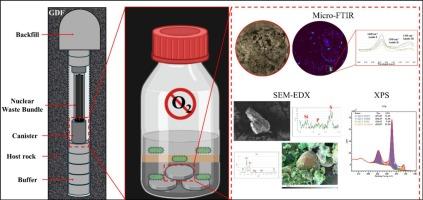地质处置设施新型储罐材料钛的微生物腐蚀评价
IF 6.9
2区 材料科学
Q2 CHEMISTRY, PHYSICAL
引用次数: 0
摘要
为了应对全球核废料库存不断增加和迫切需要安全的长期处置办法,世界各地正在寻求地质处置设施,也称为深层地质处置库。包括英国、日本和加拿大在内的几个国家项目正在评估用于废品罐的耐腐蚀合金。其中,钛合金等新型材料因其具有保护性的TiO2薄膜而成为有希望的候选材料。然而,在与储存库相关的条件下,微生物腐蚀的威胁仍然是高度未开发的。为了解决这个问题,钛盘(2级,ASTM B348)在30 °C和60 °C的合成孔隙水的膨润土浆中培养,在严格缺氧,黑暗的条件下,模拟地下深处的GDF环境。添加电子供体(醋酸盐,乳酸盐)和电子受体(硫酸盐)来刺激微生物活性并评估长期罐装性能。所有钛样品都保留了完整的TiO2层,没有可检测到的点蚀或局部损伤。显微镜(SEM)和光谱(XPS)分析显示,氧化钛膜略有变薄,微生物存在于膨润土中,但没有腐蚀产物或金属损失的证据。微傅里叶红外光谱显示,膨润土中存在与微生物相关的官能团(蛋白质、脂质和多糖),而钛表面没有。实验设计旨在促进细菌活性,以模拟最坏的GDF生物条件。这些发现证明了钛在受激gdf样环境中具有抗微生物影响腐蚀(MIC)的优异稳定性。这项研究支持了钛罐用于核废料处理的结构可行性,并强调了在长期腐蚀评估中考虑微生物因素的重要性。本文章由计算机程序翻译,如有差异,请以英文原文为准。

Assessing microbially influenced corrosion of titanium as novel canister material for geological disposal facilities
In response to the growing global inventory of nuclear waste and the urgent need for secure long-term disposal solutions, geological disposal facilities (GDFs), also known as deep geological repositories, are being pursued worldwide. Several national programmes, including those in the UK, Japan, and Canada, are evaluating corrosion-resistant alloys for waste canisters. Among these, novel materials such as titanium alloys have emerged as promising candidates due to their protective TiO2 films. However, the threat of microbial corrosion under repository-relevant conditions remains highly unexplored. To address this, titanium discs (grade 2, ASTM B348) were incubated in bentonite slurries with synthetic pore-water at 30 °C and 60 °C under strictly anoxic, dark conditions, mimicking deep underground GDF environments. Electron donors (acetate, lactate) and an electron acceptor (sulphate) were added to stimulate microbial activity and assess long-term canister performance. All titanium samples retained an intact TiO2 layer with no detectable pitting or localised damage. Microscopic (SEM) and spectroscopic (XPS) analyses showed slight thinning of titanium oxide films and microbial presence co-located with bentonite, but no evidence of corrosion products or metal loss. Micro-FTIR showed functional groups associated with microbial presence (proteins, lipids, and polysaccharides) in the bentonite, but not on titanium surfaces. The experimental design aimed to promote bacterial activity by simulating worst-case GDF biotic conditions.
These findings demonstrate titanium’s exceptional stability against microbially influenced corrosion (MIC) in stimulated GDF-like environments. This study supports the structural viability of titanium canisters for nuclear waste disposal and underscores the importance of considering microbial factors in long-term corrosion assessments.
求助全文
通过发布文献求助,成功后即可免费获取论文全文。
去求助
来源期刊

Applied Surface Science
工程技术-材料科学:膜
CiteScore
12.50
自引率
7.50%
发文量
3393
审稿时长
67 days
期刊介绍:
Applied Surface Science covers topics contributing to a better understanding of surfaces, interfaces, nanostructures and their applications. The journal is concerned with scientific research on the atomic and molecular level of material properties determined with specific surface analytical techniques and/or computational methods, as well as the processing of such structures.
 求助内容:
求助内容: 应助结果提醒方式:
应助结果提醒方式:


